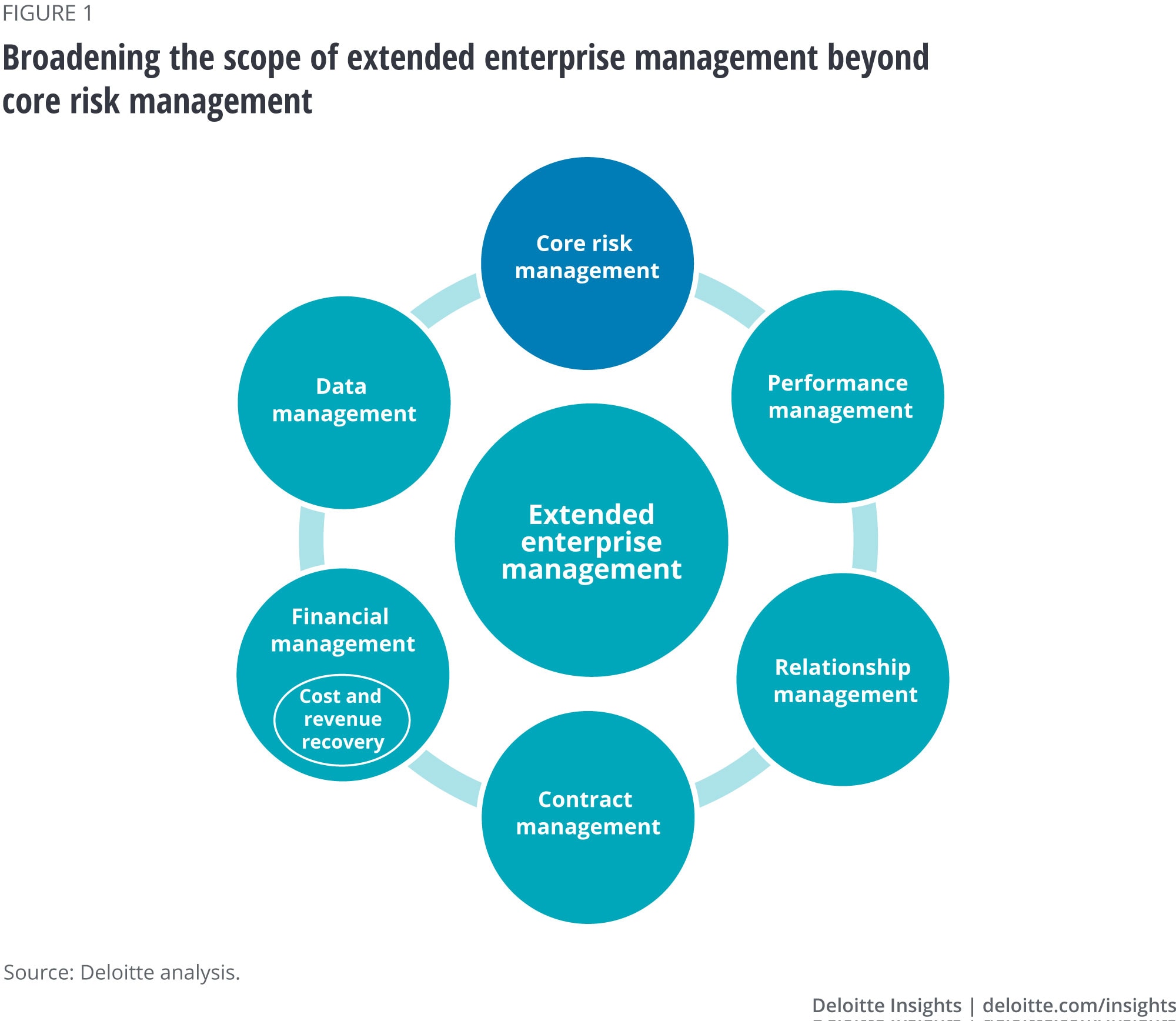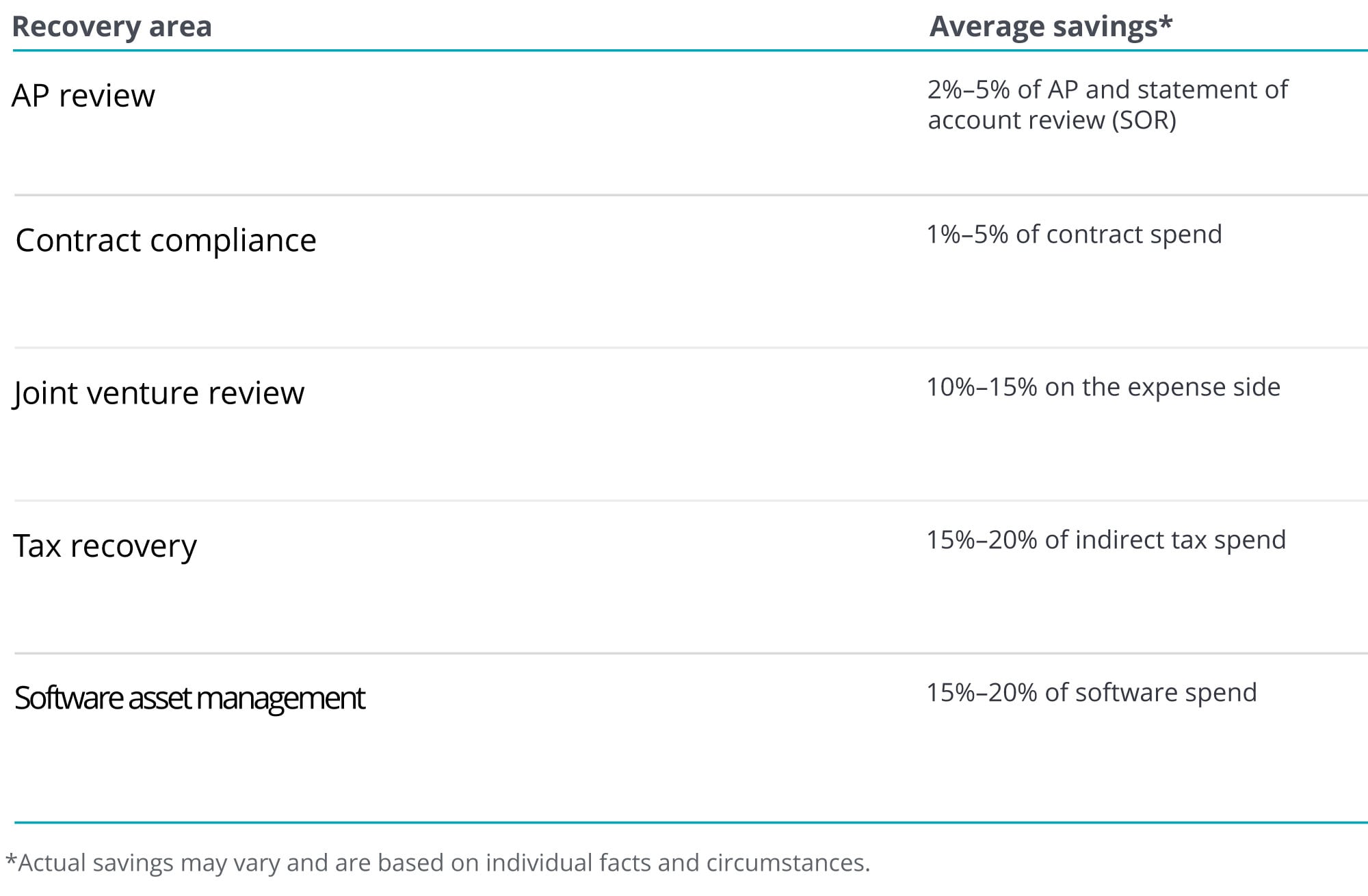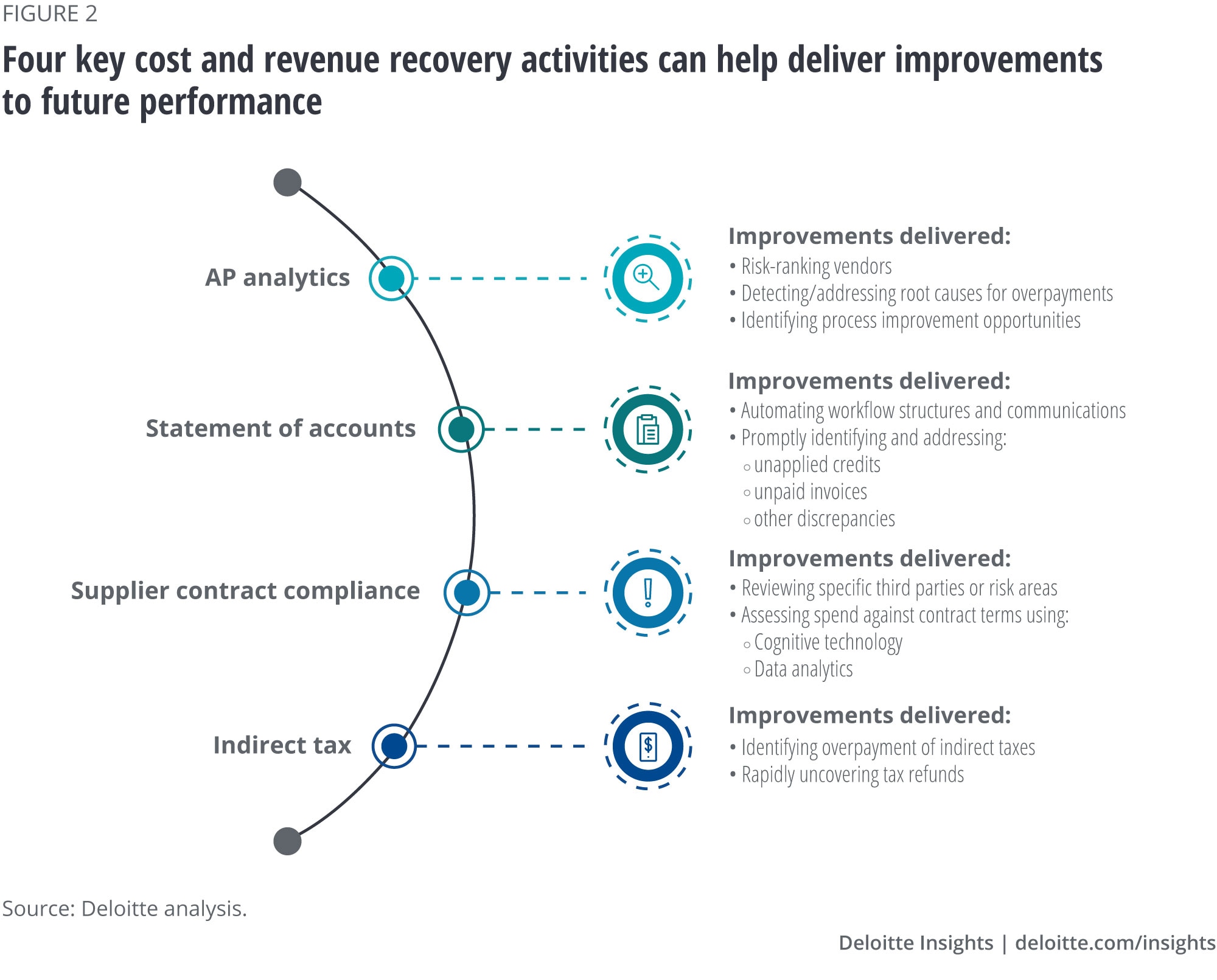
Extended enterprise perspective Taking extended enterprise management to the next level
20 minute read
08 June 2020
 Dan Kinsella United States
Dan Kinsella United States Dr. Sanjoy Sen United Kingdom
Dr. Sanjoy Sen United Kingdom Kevin Fried United States
Kevin Fried United States Travis Markowitz United States
Travis Markowitz United States
Cost and revenue recovery can be a strategic linchpin during the COVID-19 crisis. A robust cost and revenue recovery strategy not only helps achieve significant cost and savings benefits, but also enhances an organization’s ability to realize—and fund—extended enterprise goals.
Introduction
Given the scope and importance of today’s extended enterprise, organizations have been working to upgrade their management of suppliers, vendors, and partners. Yet as previously noted in Deloitte Insights,1 extended enterprise management practices are not always equal to the risks presented by the extended enterprise. One of the major reasons for this is the tendency of organizational leaders to overlook or misinterpret the role that a sound cost and revenue recovery program can play in optimizing their extended enterprise.
Learn more
Learn more about connecting for a resilient world
Explore the risk management collection
Learn about Deloitte's services
Go straight to smart. Get the Deloitte Insights app
Cost and revenue recovery generally falls within larger extended enterprise management initiatives. Many organizations have implemented certain elements of an extended enterprise management program; however, some programs lack certain other elements or deploy them in a siloed and inefficient manner. A robust cost and revenue recovery program can invigorate or reinvigorate—as well as help fund—an organization’s journey toward extended enterprise management maturity.
In today’s environment, as organizations look to recover from the COVID-19 crisis, cash has become a primary focus for the entire organization. An extended enterprise management program can assist in assessing third-party resilience and financial stability—key elements to help ensure that sales continue and cash is flowing in. Additionally, a cost and revenue recovery program can identify where cash is incorrectly flowing out—stopping leakage and keeping cash within the organization.
Regardless of the market conditions, a rigorous—yet responsible—cost and revenue recovery program can enable the organization to:
- Recover costs, stop revenue leakage, and prevent contract noncompliance in the future
- Elevate cost and revenue recovery from a piecemeal set of initiatives aimed at plugging leaks to a key element within extended enterprise management
- Develop a broader view of third-party risks through integrated contract and performance reviews
- Pay for upgrades to the extended enterprise management program, because cost and revenue recovery initiatives generally fund themselves
- Improve processes, controls, and risk management related to all third-party relationships
- Create third-party relationships characterized by mutual goals, greater transparency, and improved communication and performance
The last benefit mentioned above should also be viewed as a goal. Executives may be reluctant to commission rigorous reviews of third parties, fearing that they signal lack of trust or a need to “police” the relationship. However, in practice, cost and revenue recovery findings are rarely employed in a confrontational manner. Rather, they are used to renegotiate an existing contract or to negotiate more favorable terms upon renewal.
Most third parties take cost and revenue recovery reviews in stride, even under these current unprecedented conditions. Few vendors set out to take advantage of their customers. Indeed, they often face the same challenges as their customers, given fragmented systems, informal approaches, and failure to track contract terms, billings, and performance. The impact an organization feels from COVID-19 is likely also being felt by their third parties; because of this, the calculated implementation of a cost and revenue recovery program or review at this time can be used to help strengthen the relationship between the parties by collaboratively confronting challenges and concerns in the review process.
Here are some examples (sidebars, “A company recovers cash” and “A manufacturer achieves sustainable savings”) of how two companies achieved significant cost and savings benefits through an extended enterprise management program focused on cost and revenue recovery.
A true cost and revenue recovery program not only recovers costs and plugs leaks, but also gives management tighter control over the extended enterprise along with an enhanced ability to realize extended enterprise goals.
From extended enterprise risk management to extended enterprise management: The journey to extended enterprise maturity
Programs for managing third-party relationships and the extended enterprise go by various names, and most organizations use their own internal titles for their programs. Regardless of nomenclature, a program can be characterized by its level of maturity. A mature extended enterprise management program will go beyond contract review, compliance, risk management, and cost and revenue recovery. These are parts of extended enterprise management but should not be mistaken for extended enterprise management.
A mature extended enterprise management program will include the following elements:
- Third-party risk management: Managing the full range of risks associated with third-party relationships while optimizing and protecting the value delivered
- Performance management: Assessing third parties’ service delivery against service-level agreements, key performance indicators, and other benchmarks, as well as addressing discrepancies
- Relationship management: Fostering productive relationships with third parties based on mutual strategic objectives for the arrangement and achievement of those objectives
- Contract management: Managing contract creation, execution, maintenance, and analysis to optimize financial and operational performance while minimizing risk
- Financial management: Managing budgeting and forecasting and verifying the accuracy of purchase orders, invoices, and transactions; cost and revenue recovery is the main driver of this element of extended enterprise management
- Data management: Maintaining the integrity of data and information on third party arrangements and seeing to its accuracy, accessibility, completeness, and security
A company recovers cash
The challenge
Over a four-year period, this organization had incurred around US$100 billion in expenditures across thousands of suppliers, millions of invoices, and a wide range of categories. In this environment, some of the specific problems were:
- Numerous employees having the authority to sign purchase orders
- Lack of consistent contract management systems and mechanisms for reviewing payments to suppliers against contract terms
- Known overspending without knowledge of where it was occurring within this large number of vendors, accounts, and payments
The approach
Given the need to conduct a robust accounts payable (AP) review and to position AP to prevent future overspending, the engagement team applied the following tools:
- AP analytics to locate and prioritize areas most prone to overpayments and other erroneous charges, and to identify additional recovery and process improvement opportunities
- Statement of accounts to automate invoicing and communication workflows to accelerate recovery of monies that were due to the organization because of account discrepancies
- Supplier contract compliance to assess spend against contract terms through data analytics for specific third parties, with the aim of identifying cost recovery and process improvement opportunities
The outcome
As a result of this project, the organization identified more than US$75 million in overspending occurring due to a multitude of issues—duplicate payments, unrealized credits, miscalculated incentives, and invalid pass-through costs to suppliers. Deep-dive analytics applied to spend versus specific supplier contract terms was critical in generating these findings.
A manufacturer achieves sustainable savings
The challenge
This global organization faced increasing margin pressure and identified the need to achieve sustainable savings through strategic sourcing. The specific challenges included:
- Fragmented purchase and payment decision-making processes across more than 200 facilities worldwide
- Lack of spend visibility across multiple Enterprise resource planning (ERP) systems
- Proliferation of specifications and suppliers
The approach
The engagement team took a three-step approach to classifying spend, analyzing suppliers, and prioritizing sourcing opportunities. These steps were as follows:
- Classify: Applying cognitive technologies, data analytics, and data visualization, the team classified around US$4 billion in spend across more than 300 categories and 22,000 suppliers. It also generated an interactive dashboard to enable understanding and reclassification of the spend.
- Analyze: The team identified more than 50 categories of spend with high fragmentation for potential near-term supplier consolidation. It also evaluated some 3,000 stock-keeping units to pinpoint drivers of price variance across different locations and suppliers.
- Prioritize: After assessing potential savings and ease of execution, the team prioritized sourcing opportunities based on eight dimensions; for specific categories, the team leveraged spend data to shape sourcing strategies for immediate implementation.
The outcome
Each of these steps provided specific results:
- The “classify” phase enhanced spend visibility as well as purchase and payment decision-making across the organization.
- The “analyze” phase assessed sourcing opportunities by providing a clear picture of supplier fragmentation and the drivers of price variances.
- The “prioritize” phase identified six spend categories for immediate implementation of sourcing strategies, based on potential savings and ease of execution.
How extended enterprise management is evolving—and where cost and revenue recovery fits
In many organizations, greater CEO and board involvement is accelerating the broadening of the performance-based extended enterprise management role, where cost and revenue recovery is an integral component of financial management (figure 1). These organizations tend to adopt a more centralized or even a federated approach to drive consistency as well as coordination across business units/geographies. In many cases, they establish dedicated teams that manage other related aspects of their third-party relationships, including contractual obligations, data, and the individual relationship itself in the case of critical/strategic third parties.

Deloitte's research found that cost reduction is the reason cited most often for investing in extended enterprise management, with 62% of respondents citing it as such in 2019, up from 48% in 2018.2 This places cost and revenue recovery at the heart of extended enterprise management, but that is not always how cost and revenue recovery is viewed. Most often, it is seen as pure cost or revenue capture led by the procurement or sales/marketing team rather than a strategic linchpin in extended enterprise management. While central extended enterprise management teams often have the appetite to do more, our experience indicates that they are sometimes constrained, as cost and revenue recovery is not perceived as one of their core responsibilities.
While central extended enterprise management teams often have the appetite to do more, they are sometimes constrained as cost and revenue recovery is not perceived as one of their core responsibilities.
Indeed, organizations pursue varied goals in addition to cost reduction when investing in their extended enterprise management programs. Deloitte's research found these motives to include: reducing third-party incidents (cited by 50% in 2019 versus 43% in 2018); addressing areas of regulatory scrutiny (49% versus 43%); and internal compliance requirements (45% versus 41%).3 This implies there is a lot at stake for organizations when it comes to extended enterprise management—from the financial, operational, regulatory, reputational, and strategic standpoints.
In addition, many boards have become increasingly aware of their extended enterprise management responsibilities and their roles in overseeing cost and revenue. Although extended enterprise management has risen in priority on board agendas, many organizations exhibit an “execution gap” between what the board believes is happening and the reality on the ground. A cost and revenue recovery program can be a valuable instrument for helping to close that gap by making the tangible gains from the board’s investment in extended enterprise management a reality.
Where some organizations are falling short
Within the process of managing third-party relationships, many organizations do a reasonably good job on the front-end activities of defining requirements, screening, selecting, contracting, and onboarding vendors. It is in the back-end activities—managing and monitoring performance, risk, and compliance, and renewing or terminating the contract—where challenges tend to arise. These challenges are often heightened during an economic crisis, such as the one caused by the COVID-19 pandemic, as organizations that are not closely connected with their suppliers may find it more difficult to conduct business with the extended enterprise and execute on recovery plans.
In addition, efforts to enhance extended enterprise management tend to be fragmented and episodic. For example, the procurement function might work on supply chain improvement; risk and compliance might assess exposures and review compliance failures; sales and marketing may be concerned about intellectual property infringement; and the board may enquire about reputational risks posed by third parties. An invoice or AP assessment team, or internal audit, may perform periodic reviews or audits.
Such activities and approaches rarely add up to a mature extended enterprise management program. A properly focused, well-defined, and rigorously executed cost and revenue recovery program can enable management to enhance the organization’s extended enterprise management maturity. This begins with avoiding common pitfalls and taking a holistic approach to cost and revenue recovery.
Navigating through a crisis
As the effects of COVID-19 are felt around the world, companies are looking to respond, recover, and ultimately thrive in the “next normal.” Whether it is your business, your supplier’s business, or your customer’s business, there is potential disruption along the supply chain. Whatever the circumstance, it is important for businesses to think ahead to be in a state of readiness to resolve these challenges to protect the future of the business and preserve important commercial relationships.
The implementation of a cost and revenue recovery program during a crisis can help an organization strategically evaluate its third-party landscape and understand where it may capture value in the short, medium, and long term.
- Short term: Quick implementation of AP analytics, statement of accounts, and indirect tax elements can help to identify cost recovery opportunities with minimal third-party involvement. Moreover, it can enable generation of cash flow back into the organization and help self-fund future stages of the program through nonconfrontational, standard business activities.
- Medium term: Cost and revenue recovery-focused third-party risk assessment and contract review can help identify potential suppliers for review. An organization can also pilot audits on select suppliers. As necessary, alternative recovery mechanisms, such as deferred payment or invoice discounts, may be utilized to build a relationship with the third party.
- Long term: Organizations can aim to emerge from the crisis and thrive with a fully implemented cost and revenue recovery program to continually monitor cost and revenue leakage, improve contracts and third-party relationships, and strengthen the organization’s extended enterprise management program.
Crisis events have the potential to have material detrimental impacts on an organization. However, those that navigate intentionally and actively through a crisis can develop learnings and capabilities that set them apart from the competition. Such capabilities, planned and honed during an organization’s response to the current crisis, can help provide better outcomes for employees, optimize mid-crisis financial outcomes, and result in an organization that is more resilient and better prepared to face future crises.
How to avoid cost and revenue recovery pitfalls
A cost and revenue recovery program should not only recover cash but also add direction, structure, and funding to the extended enterprise management program by analyzing contract terms, performance, and payments, and then enabling management to rationalize the extended enterprise strategy. Recovered cash can fund additional improvements, with a good number of them coming from enhanced life cycle management, consolidation of vendors, and use of shared services and managed services.
This calls for a strategic approach to cost and revenue recovery, which many organizations fail to take. Common pitfalls in prevailing approaches to cost and revenue recovery include:
- Incorrect focus: It’s common for organizations to focus on the largest contracts by expenditure and to overlook more complex contracts. The “low-hanging fruit” approach can misdirect efforts, leave money on the table, and limit cost and revenue recovery efforts to only recovering cash.
- Overly narrow scope: Viewing cost and revenue recovery as distinct from extended enterprise management limits opportunities to establish mutual goals and increase transparency with third parties. It also fails to move the organization from passive monitoring to proactive assessment.
- Failure to leverage technology: Technologies such as robotic process automation and machine learning can automate repetitive manual knowledge work associated with contract and account reviews. Contract management software can help in scoping cost and revenue recovery initiatives.
- Failure to set proper expectations: A framework for cost and revenue recovery audit selection at or after the one-year mark and then at least annually should be established upon onboarding as part of extended enterprise management.
- Misunderstanding of financial impact: Extended enterprise management programs are often seen as costly to develop and maintain, but they can be cost-neutral when amounts recovered and saved by cost and revenue recovery are considered.
These pitfalls can usually be attributed to the lack of strategic alignment between the cost and revenue recovery program and the larger extended enterprise management strategy. Taking the time to achieve this alignment can have benefits. A good cost and revenue recovery initiative focuses on contract terms, performance, and payments that can generate cash (see sidebar, “Gains to be made from a cost and revenue recovery program aligned with extended enterprise management”) and drive enhancements to extended enterprise management.
A good cost and revenue recovery initiative focuses on contract terms, performance, and payments that can generate cash and drive enhancements to extended enterprise management.
Gains to be made from a cost and revenue recovery program aligned with extended enterprise management
Initiatives through which organizations realize cost reduction by enhancing extended enterprise management include:
- Overpayment recovery programs, which typically reclaim up to 5% or more of annual procurement cost in aggregated gains.
- Revenue assurance initiatives related to third-party sales, which can recover up to 5%–10% in additional earnings.
- Strategic technology investments, which can reduce annual extended enterprise management operating costs by more than 10%–20%.
- Shared services solutions for extended enterprise management functions, which have reduced the costs of standardized management processes by up to 15%–30%.
- Managed services solutions for extended enterprise management, which can reduce annual third-party management operating costs by 25%–50%.
Specific areas of opportunity for cost and revenue recovery programs typically include:

A four-pronged approach to cost and revenue recovery
A fruitful approach to cost and revenue recovery will not only look back to recover misspent money but also look forward to improve future performance. Future improvement occurs primarily through benchmarking to industry standards, right-sizing third-party relationships, identifying opportunities to streamline processes, and automating controls and monitoring. Four key cost and revenue recovery activities—AP analytics, statement of accounts, indirect tax, and supplier contract compliance—combine to drive these improvements (figure 2).

While they’re complementary in nature, each of these cost and revenue recovery activities can also be performed separately, depending on the organization’s spend management, extended enterprise management maturity, and objectives. Here’s how:
- AP analytics leverages data management, analytics, and visualization to identify duplicate payments, overpayments, and other erroneous charges. The resulting output assists in risk-ranking vendors, detecting root causes, and identifying process improvement opportunities.
- Supplier contract compliance entails a review of specific third parties or risk areas to assess spend against contract terms through cognitive technology and data analytics. This activity compares historical transaction data with contract terms for populations, rather than samples, of accounts, typically identifying overcharges of 1%–5% of the contract spend.
- Statement of accounts automates workflow structures and communications (such as emails) to quickly identify and address unapplied credits, unpaid invoices, and other discrepancies. This process, which begins with about 50 vendors and is then iterated with waves of suppliers, can be scaled up to address thousands of third-party relationships.
- Indirect tax reviews apply cognitive technologies to evaluate structured and unstructured historical data to rapidly uncover tax refunds. A recovery and remediation platform can identify overpayment of indirect taxes on transactions, and overpayment due to errors, amounting to 1%–2% of the related spend.
A strategic supplier analysis prioritizes tasks within these four activities based on contracts, AP extracts, purchase orders, invoices, and vendor master databases. Risk factors and potential flags include contract type, invoice volume, error history, incentives, inclusion or absence of certain contract terms, asset- or geography-specific exposures, and quality of existing controls. The nature and length of the relationship are also considered.
In practice, the same AP data extract supports each of these four activities, and the AP analytics and indirect tax prongs leverage the same data sets. This provides efficiency and expanded—even total—coverage of accounts while improving cash recovery. This technology-enabled approach can complement or replace existing reviews and audits, and can achieve more effective results compared to fragmented, episodic, sample-based methods of monitoring spend and performance.
A fruitful approach to cost and revenue recovery will not only look back to recover misspent money but also look forward to improve future performance.
Leveraging cost and revenue recovery to enhance extended enterprise management
With the extended enterprise becoming a business reality, the need for closer alignment between cost and revenue recovery and extended enterprise management at the operational and governance levels has become clear. It’s not just about cost and revenue recovery; it’s also about a way of conducting third-party relationships that are strategically, operationally, and financially vital to the organization.
To begin moving toward this way of managing the extended enterprise, consider the following actions:
- Designate an owner of cost and revenue recovery. Lack of clear ownership is one of the most common reasons for the lack of consistent, strategic cost and revenue recovery. Designating an owner of cost and revenue recovery—or championing the initiative yourself—can create clarity regarding accountability and responsibility, engage the executive team and the board, and increase the impact of cost and revenue recovery and extended enterprise management within the organization.
- Analyze and prioritize your vendors and partners. Rather than settle for the proverbial low-hanging fruit, apply supplier analysis and prioritization to your entire extended enterprise. The resulting systematic tiering of third parties clarifies potential value relative to potential effort in the light of key risks. Digitizing contract and invoice data and applying cognitive analysis and data visualization generates more complete coverage, and often surprising results.
- Assess your extended enterprise management program. Assess the strengths and weaknesses of each element of your extended enterprise management program: risk, performance, relationship, contract, financial, and data management. Consider business requirements, vendor performance, data from past initiatives, internal audit findings, and other relevant sources. Aim to justify each relationship and rationalize the third-party ecosystem. Also, consider strategies such as shared services and managed services.
- Take a data-driven approach. Relying on data and data analytics drives a fact-based approach to cost and revenue recovery as well as fact-based findings. With those findings, the organization can take the steps it sees as appropriate given its goals, contract terms, and relationships. Third parties should generally be open to good-faith approaches and understand the need for cost and revenue recovery reviews, right-to-audit clauses, and exercising those rights. Mutual goals and increased transparency are now competitive differentiators among many extended enterprise participants.
- Choose the right cost and revenue recovery adviser. Consider engaging with an organization that has the length of experience, breadth of professionalism, and depth of understanding required to meet your cost and revenue recovery needs and help you achieve your goals. Seek an organization that will review all spend categories, help you enhance payment processes, and provide insights that can help improve your management of third-party relationships.
For a host of reasons, cost and revenue recovery represents an excellent vehicle for any executive team that wants to enhance the performance of the extended enterprise and better understand and manage the costs, risks, and opportunities that third parties present to the organization.
Explore COVID-19 resources
-
The heart of resilient leadership: Responding to COVID-19 Article4 years ago
-
The essence of resilient leadership: Business recovery from COVID-19 Article4 years ago
-
Embedding trust into COVID-19 recovery Article4 years ago
-
COVID-19 return-to-the-workplace strategies Article4 years ago
-
Unlocking the lockdown: Asia Pacific’s road to recovery Article4 years ago
-
COVID-19 insights Collection











